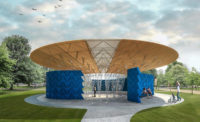When RECORD first interviewed Diébédo Francis Kéré six years ago, he spoke of his aspirations for his young—but growing—Berlin-based firm. These days, the Burkina Faso native is virtually everywhere. In the last year alone, Kéré has been the subject of a solo exhibition at the Philadelphia Museum of Art, proposed a new parliament building for his home country, and was awarded the Arnold W. Brunner Memorial Prize in Architecture from the American Academy of Arts and Letters. Later this month, the pavilion he designed for London’s Serpentine Gallery will open, marking the first time an African architect has won the prestigious commission. record sat down with Kéré at the 2017 AIA Conference on Architecture in Orlando, where he was the opening speaker, to discuss his recent and upcoming work.
Architectural Record: Online, back in October, we ran a story about your plan for the parliament building in Burkina Faso. Is that happening?
Diébédo Francis Kéré: It’s an amazing project. The parliament president told me, “I love your design, and our country needs this in the center of our capital, but we have to see how to get the funding. If I could, I would start to build it with you tomorrow.” The country is coming out of a very hard time—30 years of corruption and a revolution. The design has launched a debate about how symbolic buildings like a parliament house should look. I thought, we have to consider what is important for Burkina Faso. And so that was the idea with the pyramid—it’s transparent and has a garden space, so the people can really engage with it.
What do you have going on in Berlin?
I was asked to design a theater for Volksbühne, a 100-year-old theater company. The new director, Chris Dercon, wants to open the theater to the world, so I designed a satellite theater in a hangar [at Berlin Tempelhof Airport]. This particular airport is very important, because, during the cold war, the U.S. used it to bring food to people in Berlin.
So now, putting a theater for 800 to 1,000 people inside of it, I said, “Can I drill?” No! “Can I hang things?” No! It’s all historically protected. Instead, I thought, let’s create a movable thing. All the seating can be moved like an accordion, and the stage can be used for different purposes. We’ll put wheels on the entire structure, to move the whole thing outside, as you would move an aircraft. The moving out becomes theater in itself.
Also, there are Syrian refugees staying in some of the hangars nearby. They can’t leave, so it’s difficult for them to make relationships and connections. I thought, if we move the theater out of the hangar and bring everyone together in front of it, we’ll get the refugee and the Berliner to connect—the new citizen with the existing citizens. People loved that idea.
It sounds as if it captures the zeitgeist. When will construction start?
We’re waiting on the financing from the state. It’s not easy.
Anything else happening now in Germany?
There’s a church and community in Muenster, too. An old military barracks. It’s still in the competition phase, but it’s looking good. We won the master plan a couple of years ago. Cross your fingers.
With the Serpentine Pavilion coming up, this is a big moment for you!
Yes, it is a great honor. But the pressure’s great too, because you have to succeed. Look at who has been there before me! [Zaha Hadid, Oscar Niemeyer, Frank Gehry, and others.] When I discovered that I won, I was like, c’est pas moi!—it’s not me! They said, “Yes, you.”
Are you traveling to London often, then?
Yes, I have been there several times already for fabrication, discussion—and we went through fire tests a lot.
Fire tests?
Yes! The structure has to stand. A crowd will come there, so it has to be secure.
Are you going to meet the Queen?
That would be a dream—which I don’t think will come true.
Do people from your hometown in Burkina Faso want to be architects now? Do they want to go to architecture school?
Friends have told me that kids say they want to be “Francis.” So I am a profession. It’s wonderful.



Post a comment to this article
Report Abusive Comment